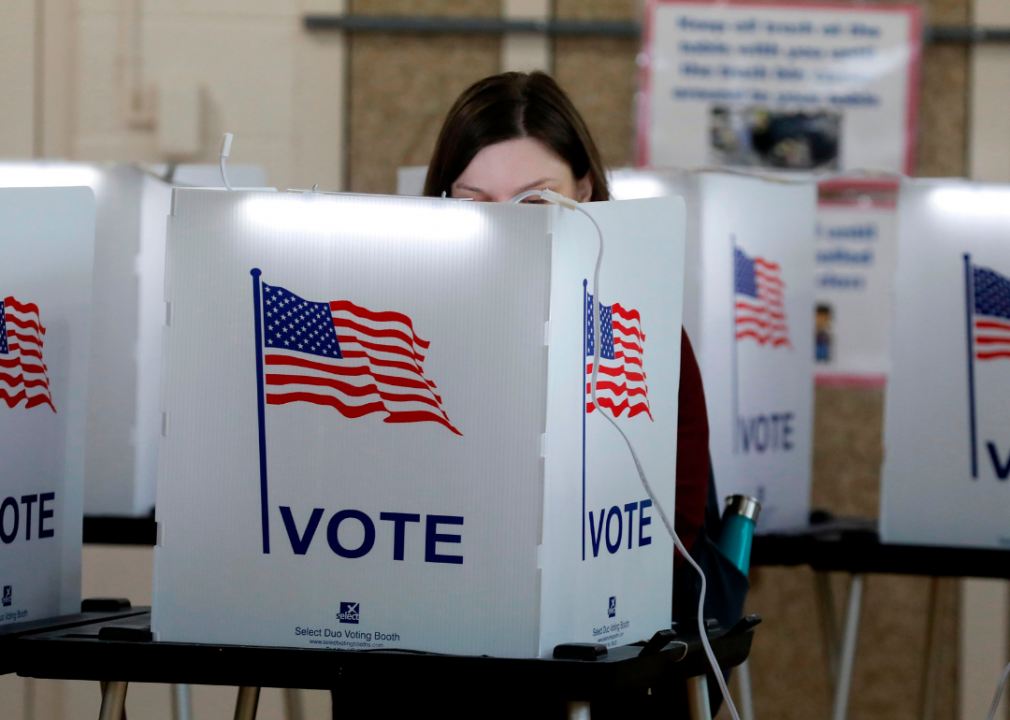1.3 million votes: See the demographics of Idaho’s voting population
JEFF KOWALSKY // Getty Images
1.3 million votes: See the demographics of Idaho’s voting population
In 2020, 158.4 million citizens—almost two-thirds of estimated eligible voters—voted in the presidential elections, according to the Pew Research Center. The number represented a higher than average turnout, with people voting in numbers not seen since 1980 and possibly well before.
Stacker compiled voter demographics for each state and Washington, D.C., using the 2019 U.S. Census Bureau’s American Community Survey (released in September 2020). Each slide shows the state’s voting-eligible population (citizens who are 18 or older) and the breakdown of that population by sex, age, race, and education. Economic statistics are not included because the American Community Survey does not account for COVID-19, which affected unemployment, poverty, and medical insurance status for millions of Americans. In order to avoid making any assumptions about the data or the participants of the American Community Survey, Stacker used the exact wording of the “race” and “sex” framework that was provided in the census data.
Keep reading to see the voter demographics of your state.
Idaho by the numbers
– Voting-eligible population: 1,282,630
– Breakdown by sex: 49.6% male, 50.4% female
– Breakdown by age: 21.2% 18-29 years old, 24.9% 30-44 years old, 31.6% 45-64 years old, 22.2% 65+ years old
– Breakdown by race: 91.9% White, 0.5% Black or African American, 1.0% Asian, 8.6% Hispanic or Latino, 0.0% Native American or Alaska Native, 0.0% Native Hawaiian or Pacific Islander, 2.3% two or more races
– Breakdown by education: 1.8% less than high school education, 5.9% some high school (no diploma), 27.5% high school graduate or equivalency, 27.9% some college (no degree), 10.3% associate’s degree, 17.8% bachelor’s degree, 8.8% graduate or professional degree
Predominantly made up of a white voter population, the Gem State has voted GOP 70% of the time since 1900. The rather red state reported a record turnout in the 2020 primary with up to 38% voting, a number unseen since the 1980 election at a little less than 31%. The 2016 Electorate’s Idaho Profile revealed a tied voting population between balloters ages 18–44 and voters between 45–65.
By percentage, voters aged 45–64 are the highest in every state, with registered voters over the age of 45 comprising more than half the country’s population. Older voters also trend toward turning out to vote at a higher rate and played a significant role in former President Donald Trump’s 2016 victory in Florida.
Along racial lines, Black or African American voters in Louisiana and Georgia comprise more than 30% of the state’s registered voters. California and Texas—which award the most electoral votes at 55 and 38, respectively—boast the highest numbers of Latino voters. On the other end of the spectrum, West Virginia and Maine boast the highest percentage of white voters. A number of states had already seen record voter turnouts, with 16 seeing more than half of its registered voters casting a ballot before Election Day.
Continue reading for a glimpse into the voter demographics of neighboring states.
Washington
– Voting-eligible population: 5,409,035
– Breakdown by sex: 49.6% male, 50.4% female
– Breakdown by age: 20.7% 18-29 years old, 25.4% 30-44 years old, 32.3% 45-64 years old, 21.7% 65+ years old
– Breakdown by race: 80.5% White, 3.6% Black or African American, 6.9% Asian, 7.8% Hispanic or Latino, 1.4% Native American or Alaska Native, 0.5% Native Hawaiian or Pacific Islander, 4.5% two or more races
– Breakdown by education: 1.9% less than high school education, 5.2% some high school (no diploma), 23.6% high school graduate or equivalency, 24.9% some college (no degree), 10.3% associate’s degree, 21.9% bachelor’s degree, 12.2% graduate or professional degree
A large voting-eligible population and 12 electoral votes give Washington a strong influence in any presidential election. Since the Evergreen State joined the Union in 1889, the collective voter demographics, including sex, age, race, and education, cast their votes almost equally between both political parties, with the exception of the last eight elections. Washington’s cumulative picks since 1900 earned the state a 73.3% record for choosing the eventual commander in chief.
Wyoming
– Voting-eligible population: 434,852
– Breakdown by sex: 50.7% male, 49.3% female
– Breakdown by age: 20.7% 18-29 years old, 24.6% 30-44 years old, 32.1% 45-64 years old, 22.6% 65+ years old
– Breakdown by race: 93.0% White, 7.7% Hispanic or Latino, data not available for other races
– Breakdown by education: 1.3% less than high school education, 4.5% some high school (no diploma), 30.5% high school graduate or equivalency, 25.8% some college (no degree), 11.2% associate’s degree, 17.4% bachelor’s degree, 9.2% graduate or professional degree
Of all U.S. states, Wyoming has the lowest population, slimming down its collective voting pool. However, unlike other regions where the populace affects electoral votes, Wyoming is notably overrepresented in the Electoral College, which has caused some concern in past elections. White voters account for a large majority of the ballots cast in Wyoming, which has voted Republican in every presidential election since 1952 except for one.
![]()






